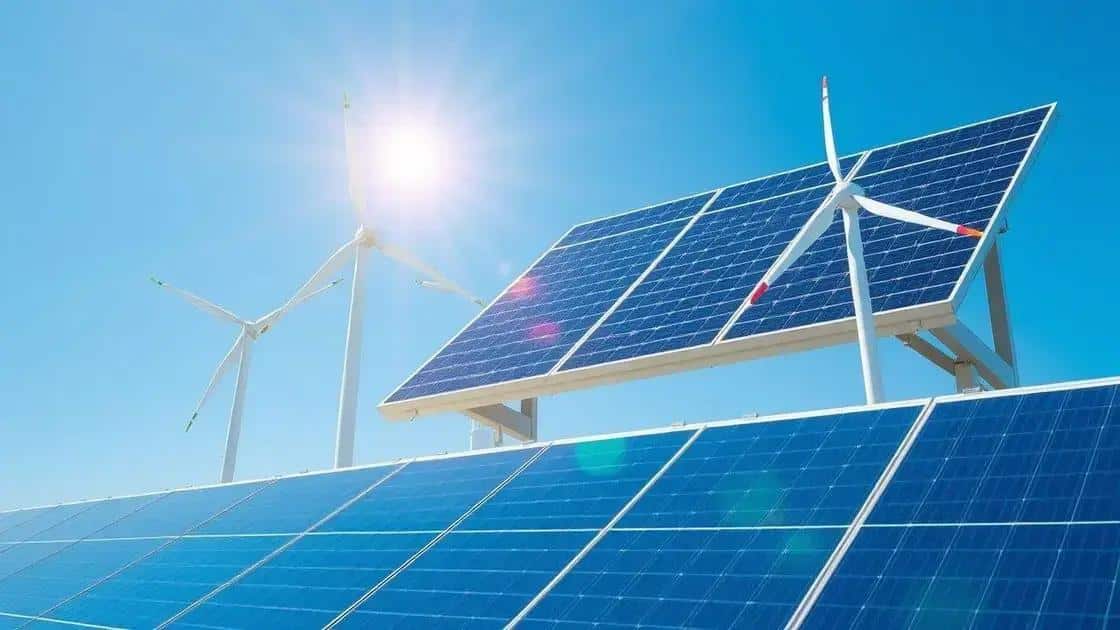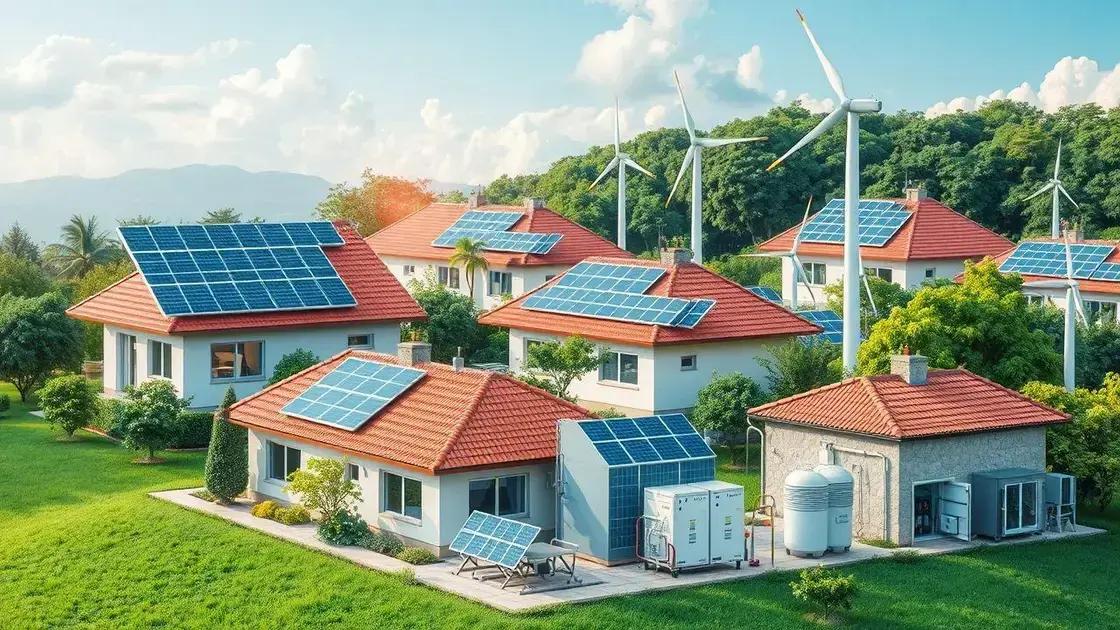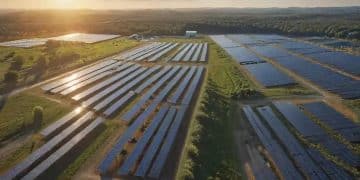Insights on climate tech developments: what’s next?

Future trends in sustainable energy solutions include the rise of renewable energy sources, improved energy storage technologies, and decentralized energy production, all crucial for combating climate change and enhancing energy efficiency.
Insights on climate tech developments are crucial as we navigate a rapidly changing environment. Have you ever wondered how the latest innovations can impact sustainability? Let’s delve in.
Recent breakthroughs in climate technology
Recent breakthroughs in climate technology are reshaping the way we think about sustainability and environmental responsibility. Innovations in this field are not just theoretical; they are making a tangible difference in the fight against climate change.
Innovative Carbon Capture Solutions
One of the most exciting advancements involves capturing carbon emissions directly from the atmosphere. These solutions are crucial for reducing greenhouse gases and slowing down global warming. Here are some notable technologies:
- Direct Air Capture: Facilities that use chemical processes to extract CO2 from the air.
- Bioenergy with Carbon Capture and Storage (BECCS): Combining biomass energy with carbon capture to create a sustainable energy cycle.
- Ocean-based Solutions: Enhancements that leverage marine ecosystems to absorb carbon.
As we look at the impact of these technologies, it becomes clear that they are vital. By reducing atmospheric carbon levels, we can work towards a healthier planet.
Advancements in Renewable Energy
Renewable energy sources are also seeing rapid developments. Innovations in solar, wind, and hydroelectric power are becoming more efficient and less costly. For example, new solar panels are being developed that can harness more sunlight and generate more power, even in cloudy conditions. This is crucial for expanding access to clean energy.
Further, offshore wind farms are gaining attention due to their vast potential for energy generation. Improved turbine technology allows them to operate more efficiently, capturing more wind energy. These developments not only benefit the environment but also help reduce energy costs for consumers.
With the combined benefits of these technologies, transitioning to a sustainable energy future seems increasingly attainable. The climate tech sector is ripe for growth, driven by innovation and the urgency of climate action. This momentum gives us hope as we face global challenges.
Big tech companies are investing heavily in climate tech, recognizing its importance. This influx of funding fuels exciting projects that can significantly impact our environment. As breakthroughs continue, we may discover even more ways to harness technology for sustainability.
In conclusion, the recent advancements in climate technology represent a beacon of hope. They showcase human ingenuity and our ability to adapt in the face of climate challenges. By embracing these innovations, we can pave the way toward a greener, more sustainable future.
The role of startups in climate innovation

The role of startups in climate innovation is increasingly vital as we seek new solutions to environmental challenges. These nimble companies often bring fresh ideas and bold approaches that large corporations may overlook. Startups are uniquely positioned to experiment with innovative technologies and business models, driving significant changes in the climate tech landscape.
Driving Disruptive Technologies
Many startups are focused on developing disruptive technologies that challenge traditional methods of energy production and consumption. By introducing new ways to harness renewable energy, they contribute significantly to reducing carbon footprints. For instance, some startups are creating advanced materials for solar panels that increase efficiency and lower costs.
- Battery Storage Innovations: Startups are working on improving battery technologies, making renewable energy sources more reliable and efficient.
- Sustainable Agriculture Tech: Innovative solutions are being developed to enhance crop yield while minimizing environmental impact.
- Circular Economy Models: Startups are promoting recycling and resource recovery, turning waste into valuable materials.
This focus on disruptive technologies not only promotes sustainability but also fosters economic growth by creating jobs and attracting investment. With their agility, startups can respond quicker to market needs and environmental imperatives.
Fostering Collaboration
Another important aspect of startups in climate innovation is their ability to foster collaboration. Many of these companies work in partnership with larger corporations, research institutions, and government entities. This collaboration enhances knowledge sharing and accelerates the deployment of innovative technologies.
Startups often act as a bridge, connecting scientific research with practical applications. For example, they might take research concepts from universities and translate them into market-ready products. This pipeline of innovation helps to ensure that effective solutions reach the consumers and businesses that need them.
Moreover, the investment landscape for climate tech is expanding. Venture capitalists and impact investors are increasingly looking to fund startups that have a strong environmental focus. This influx of capital enables young companies to scale their innovations rapidly.
The contributions of startups are pivotal in shaping a sustainable future. They are not only addressing immediate climate challenges but are also setting the stage for long-term environmental sustainability. By prioritizing innovation, startups become essential players in the fight against climate change.
Key challenges facing climate tech today
Key challenges facing climate tech today are creating hurdles in the race for sustainability. Despite the rapid growth of technologies aimed at reducing our carbon footprint, several factors are still hindering progress. Understanding these barriers is essential for developing effective solutions.
Funding and Investment Issues
One of the major challenges is securing sufficient funding. While interest in climate technology has increased, many startups still struggle to access the necessary capital. Here are some points to consider:
- High Initial Costs: Developing new technologies often requires substantial upfront investment.
- Market Uncertainty: Investors may hesitate due to the unpredictability of new markets and technologies.
- Limited Government Support: Inconsistent policies can deter investment in climate solutions.
This lack of funding can slow the pace of innovation, meaning fewer solutions reach the market to combat climate change.
Regulatory and Policy Barriers
Another significant challenge comes from regulatory frameworks. Unclear or inconsistent regulations can create confusion for companies trying to innovate. Adapting to varying policies across regions can prove difficult. Some areas face strict regulations that stifle innovation, while others lack adequate rules to ensure sustainability.
These inconsistencies can lead to a lack of standardization in technologies, making it hard for consumers to understand the benefits and applications of climate tech.
Technological Limitations
Despite many innovations, some technologies still face limitations in efficiency and scalability. Many renewable energy sources rely heavily on weather conditions, affecting their reliability. For instance, solar panels are ineffective on cloudy days. Additionally, energy storage remains a significant hurdle, as batteries need to improve in terms of capacity, cost, and lifespan.
Furthermore, the integration of new technologies into existing infrastructures can be challenging. Updating old systems with modern solutions often requires extensive planning and investment.
Lastly, public awareness and acceptance play a crucial role. Many consumers are unaware of the benefits of adopting climate technologies or may remain skeptical about their effectiveness. Overcoming these perceptions is essential for widespread adoption.
Future trends in sustainable energy solutions

Future trends in sustainable energy solutions are essential to building a cleaner and more efficient world. As challenges like climate change and energy scarcity become more pressing, innovative technologies will play a vital role in how we harness, distribute, and use energy.
Rise of Renewable Energy Sources
The shift towards renewable energy will continue to grow, with solar and wind power leading the charge. These energy sources are becoming cheaper and more accessible for consumers and businesses alike. Many countries are investing heavily in infrastructure to capture solar power and wind energy, maximizing their potential.
- Improved Solar Technology: Developments in solar efficiency are making panels produce more energy with less space.
- Offshore Wind Farms: These farms are set to expand significantly, tapping into stronger winds and larger areas.
- Hydropower Optimization: Innovations in dam design and turbine efficiency are enhancing hydropower’s reliability.
With better technology, the world can better utilize these resources, leading us toward a greener future.
Energy Storage Innovations
Energy storage is another crucial aspect of sustainable energy solutions. As more renewable energy sources come online, effective storage systems will be needed to manage fluctuations in supply. Batteries are improving and becoming more affordable, allowing for better energy management.
Technologies like solid-state batteries and flow batteries present new opportunities to store energy for longer periods without performance loss. This capability will enable business and residential users to rely on renewable energy even when the sun isn’t shining or the wind isn’t blowing.
Moreover, integrating smart grid technology will help optimize energy distribution, allowing users to direct energy from storage when it is most needed.
Decentralized Energy Production
The future will likely see more decentralized energy production, allowing communities to generate their own power. This shift can reduce dependency on large energy providers and enhance energy security.
Microgrids and local energy cooperatives will enable communities to produce and manage energy more sustainably. This can lead to lower energy costs and improved resilience during outages or disasters.
Additionally, advancements in home energy management systems will empower consumers to monitor their energy usage and production, making them active participants in the energy landscape.
FAQ – Frequently Asked Questions about Future Trends in Sustainable Energy Solutions
What are the key trends in sustainable energy today?
Key trends include the rise of renewable energy sources, advancements in energy storage technologies, and the shift towards decentralized energy production.
How are advancements in solar technology impacting sustainable energy?
Improvements in solar efficiency are making solar panels more effective, allowing them to generate more power even in less optimal conditions.
Why is energy storage important for renewable energy?
Energy storage allows for the capture of excess energy generated during peak production times, ensuring a stable and reliable energy supply when demand is high.
What role do communities play in decentralized energy production?
Communities can generate and manage their own energy through microgrids, leading to greater energy independence and resilience during outages.





